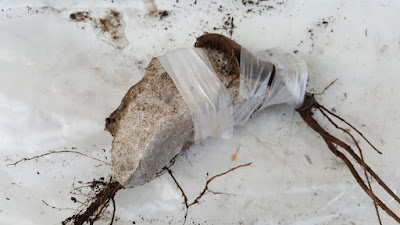So, last year I wanted to grow my own Japanese Black pine. I scoured the internet to find information. I found a good article on https://bonsaitonight.com/. That website is a great resource for all things black pine and other things. The article https://bonsaitonight.com/2011/07/01/how-to-create-seedling-cuttings-japanese-black-pine/ mentioned that he had used some methods that were found in Bonsai Today issue numbers 12 and 20 (Click on the link to find Bonsai Today 1-20 ). I found out that Kusida Matsuo the author of the article Back Pine From Seed put pine trees in a colander. When the tree grew bigger he would leave the tree in the same colander and plant the tree, colander and all in a bigger colander. Finally when the tree was big enough Mr. Matsuo would remove the tree from the bigger colander and prune the roots. He would not disturb the root ball formed in the original colander.
I am not writing about the japanese black pine per se. I am writing about the idea of
keeping the root ball intact. Here is the idea behind that. If you think about most trees and shrubs from just about any part of the world you imagine the roots in some type of soil. I'm going to generalize here. The trees may bend and sway with the wind. Snow may bend and breaks branches. However, for the most part the roots remain untouched. Those who hunt trees in the wild take special care of how they remove the tree from the soil. It is very meticulous work to remove a tree and for it to survive. Big roots are not the problem. The problem is those fine roots that absorb water and nutrients. They hunters try to not disturb these smaller roots as much as is possible.
We all know that the roots are important. Some trees are not sensitive at all to having the roots moved or cut. I have cut a four inch thick branch off of a ficus and it has rooted just fine, accidentally broken the new roots and the tree doesn't skip a beat. No harm no foul. I have also killed a few pines a couple years back because I root pruned to much, at the wrong time, etc. Yet the intention of this article is not about killing trees. It is about growth rates.
 |
| This cutting has no roots yet grew new foliage |
Here is the big picture, pruning roots on any tree will slow a tree's growth. A tree feeds itself water and minerals, the building blocks of the trees tissues through the roots. If a tree has more roots it has the capability of taking in more nutrients. Does it necessarily do that? I am not sure. If a tree had a big root system and it is reduced we can agree that the trees capabilities to absorb water and nutrients will diminish. The tree will start to grow roots to get back to equilibrium. This might hinder branch and leaf production.
Unfortunately in bonsai we can not avoid cutting tree’s roots. Cutting roots is part of the process to fit trees in a small pot. When a tree is old and refined cutting roots will rejuvenate the root system.
So, we have to cut roots, and we want to shorten the tree’s recovery time. We can do this by maintaining a tree's root ball. Just like Mr. Matsuo if we leave the roots close to the tree as untouched as possible then the recovery time will be quicker. The size of the root ball will have to coincide with the size of the tree. Another factor is the pot you use to keep your tree.
Good luck and cheers.

















